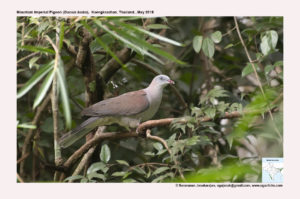Mountain Imperial Pigeon

| Mountain Imperial Pigeon Ducula badia
Etymology: · Ducula : Latin word for “Imperial , Duke” · Badia : Latin word badius – chestnut-coloured, brown. Vernacular Names: Pahari: Hukas, Ass: Parghuma,Cachar: Daohukurumagagao, Lepcha: Fomok, Nepal, Sikkim: Dukur, Dukul, Naga: Inruikurugaherba, Mani: Lamkhunu, Mal: Manti pravu, Hindi: PahadiShaha-Kabutar, Mar: PahadiShahiKavda |
Distribution in India: Resident of Himalayas, Hills of North East and Western Ghats in India.
Description: Size of 43–51 cm; wt. of 580–665 g. The head, neck and underparts are pink, brightest on hindneck and more or less suffused with grey elsewhere; crown and sides of face are pale grey; chin and throat are white; mantle, lesser and median wing-coverts are dark reddish purple; back, rump and greater wing-coverts are dark greyish brown with purple fringes, the purple fades to chestnut in worn plumage; primaries and secondaries are blackish brown; tail is blackish brown with broad, light grey terminal band; underside of tail grey is with silver-grey terminal band; ventral regions and undertail-coverts are creamy buff; iris is white or grey-white; orbital skin is dark red; bill is dark pink or red with paler tip; legs and feet are dark red with pale claws. Both the sexes are alike, but female averages smaller. The juvenile is duller, head to breast being greyer, mantle and wings are earth-brown with duller chestnut fringes, remiges are tipped chestnut, back and rump are sooty grey, pale terminal tail band only weakly developed, and feet s paler and more pinkish. The race griseicapilla has extensive purple areas on upperparts, grey tinge to rump, pale grey crown and face contrasting with pink hindneck, pale grey underparts, and cream undertail-coverts; race insignis has entirely dark vinous head and neck, mantle has faint purplish wash and underparts also like griseicapilla; iris is pale to pale bluish grey, orbital skin is purple-grey, becoming purer grey close to eye.
Habitat: It is found in primary and secondary evergreen and deciduous forests from foothills up to 2300 m.
Food Habits: It is frugivorous, feeding on a variety of fruits and berries and wild nutmegs, buds and young leaves .It occasionally descends to ground to drink.
Breeding Habits: They Breed in Mar–Aug on Sumatra and Borneo, in Jan–Apr and Jun, and in Peninsular Malaysia, in Dec–Apr and Jun–Sept. The breeding display-flight involves bird flapping wings rapidly, and then sweeps up vertically, before abruptly turning and diving down with spread tail, before repeating the display 2–3 times. The nest is a slight platform of twigs, placed up in a sapling or understorey tree, or tree-ferns. They lay a clutch of 1-2 egg. The incubation is done by both sexes.